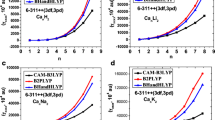Abstract
The ionicity and atomization energy of 27 bivalent metal halides have been estimated. The calculation was performed with experimental values of the interatomic distances. The atomization energy was a function of only the bond ionicity, which was determined by minimizing the energy. For layer structures, account was taken of the energy of anion polarization due to static fields induced on the anions by their asymmetric environment. The estimates of ionicity are close to those according tc Phillips. The error in calculating the atomization energy is no greater than I eV, averaging 3.5%.
Similar content being viewed by others
Literature cited
A. F. Kapustinskii and K. B. Yatsimirskii, “Lattice energy of salts formed by ions with eight-electron outer shell,” Zh. Obshch. Khim.,26, No. 4, 941–948 (1956).
T. E. Brackett and E. B. Brackett, “The lattice energies of the alkaline earth halides,” J. Phys. Chem.,69, No. 10, 3611–3614 (1965).
P. S. Yuen, R. M. Murfitt, and R. L. Collin, “Interionic forces and ionic polarization in alkaline earth halide crystals,” J. Chem. Phys.,61, No. 6, 2383–2393 (1974).
V. S. Urusov and V. B. Dudnikova, “Energy of anion polarization in layered structures,” Phys. Status Solidi B,112, No. 1, 303–310 (1982).
I. Shanker, I. P. Singh, and V. C. Jain, “Analysis of interionic potentials in alkaline earth fluoride crystals,” Physica,106, No. 2, 247–250 (1981).
G. V. Murti and V. Usha, “Cohesion in lead chloride,” Pramana,11, No. 1, 73–76 (1978).
J. C. Phillips, “Ionicity of the chemical bond in crystals,” Rev. Mod. Phys.,42, No. 3, 317–356 (1970).
V. S. Urusov, Crystal Chemistry Energetics [in Russian], Nauka, Moscow (1975).
V. S. Urusov, “Semiempirical method for calculation of atomization energies of inorganic crystals,” Dokl. Akad. Nauk SSSR,215, No. 6, 1417–1420 (1974).
O.C. Hofer and R. Ferreira, “Covalent and ionic bond orders: applications to the alkali halide molecules,” J. Phys. Chem.,70, No. 1, 85–90 (1966).
R. Ferreira, “Principle of electronegativity equalization. 1. Bond moments and force constants,” Trans. Faraday Soc.,59, 1064–1075 (1963).
R. Ferreira, “Principle of electronegativity equalization. 2. Bond-dissociation energies,” Trans. Faraday Soc.,59, 1075–1079 (1963).
R. Iezkowski, “Partial ionic character of diatomic molecules,” J. Am. Chem. Soc.,86, No. 12, 2329–2332 (1964).
V. S. Urusov, V. B. Dudnikova, and A. V. Garanin, “Calculation of solution energies of alkaline-earth metal ions in alkali halide crystals,” Phys. Status Solidi B,102, No. 2, 695–703 (1980).
R. Ferreira, “A zeroth-order approximation for bond energies, hybridization states, and bond ionicities. 1. Diatomic molecules and A1–B1 crystals,” J. Phys. Chem.,68, No. 8, 2240–2248 (1964).
E. J. Arlman, “Anion polarization and lattice energy of some metal halides MX2 and MX3 with layer and chain structure,” Recl. Trav. Chim. Pays-Bas,87, No. 10, 1217 (1968).
Y. M. de Haan, “Structure refinements, thermal motion, and Madelung constants of CdI2- and Cd(OH)2- type layer structures,” in: Molecular Dynamics and Structure of Solids, Natl. Bur. Stand., New York (1969), Vol. 301, p. 233.
H. Gutbier, “Relationship between effective atomic charge and heat of bond formation,” Z. Naturforsch. A,19, No. 10, 1154–1159 (1964).
V. N. Kondrat'ev (editor), Bond Rupture Energies. Ionization Potentials and Electron Affinity [in Russian], Izd. Akad. Nauk SSSR, Moscow (1962).
B. F. Levin, “Bond susceptibilities and ionicities in complex crystal structures,” J. Chem. Phys.,59, No. 3, 1463–1486 (1973).
R. P. Lowndes, “Dielectric response of the alkaline earth fluorides,” J. Phys. C,2, No. 9, 1595–1605 (1969).
Author information
Authors and Affiliations
Additional information
Published as a matter for discussion.
Translated from Teoreticheskaya i Éksperimental'naya Khimiya, Vol. 21, No. 6, pp. 708–713, November–December, 1985.
Rights and permissions
About this article
Cite this article
Urusov, V.S., Dudnikova, V.B. Semiempirical approximation for atomization energy of bivalent metal halide crystals. Theor Exp Chem 21, 674–678 (1985). https://doi.org/10.1007/BF00945145
Received:
Revised:
Issue Date:
DOI: https://doi.org/10.1007/BF00945145



